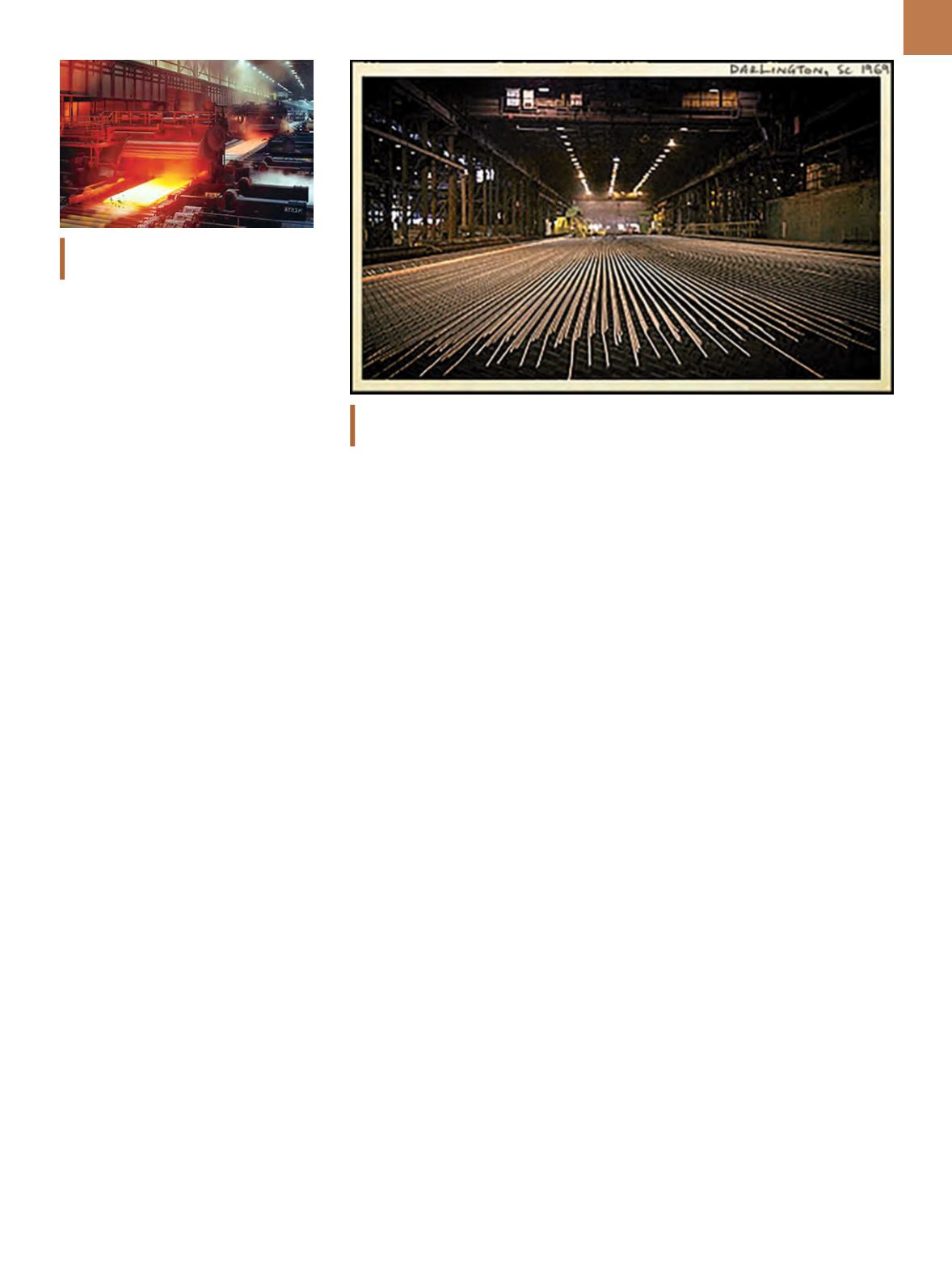

A D V A N C E D
M A T E R I A L S
&
P R O C E S S E S | J U N E
2 0 1 5
2 9
not being involved, nearly bankrupted
the company. Even so, it went into full
production in 1971. This plant became
so successful that Nucor built two more
minimills near its assembly plants in
Norfolk, Neb., and Jewett, Texas.
HEFFERNAN’S THIRD MILL
When Cargill bought out the mi-
nority shareholders of North Star Steel
in 1972, Heffernan sold his shares and
founded Co-Steel. He partnered with
Texas Enterprise to build his third mini-
mill, Chaparral Steel Co., in Midlothian,
Texas. Chaparral was equipped with
the latest technology in EAFs and con-
tinuous casters and had capacity of
200,000 tons per year, common with
these first minimills. With constant up-
grading of equipment and processes,
Chaparral produced one million tons
per year in 10 years, and two million
tons per year after another 20 years.
Through the leadership of Iverson
and Heffernan, the minimill industry
developed into 30 plants in the U.S. and
eight in Canada during the 1970s. Typ-
ical of these additional minimills was
Auburn Steel Co. in Auburn, N.Y., built in
1974 with capacity of 400,000 tons per
year. As with most of the new minimills,
it did not have an in-house market as
did Nucor with its Vulcraft Division and
Chaparral with the oil industry. Instead,
the mills were subject to the busi-
ness cycles of the steel industry. Most
of them were acquired by bigger and
more financially secure corporations.
Nucor purchased Auburn Steel and
at the same time built a Vulcraft plant
nearby to use the output. In 1975, mini-
mills had a combined output of six mil-
lion tons—a small percentage of total
steel production, which was more than
100 million tons that year.
FIRST MINIMILL FOR
FLAT PRODUCTS
A huge breakthrough in the mini
mill industry was Iverson’s new plant
dedicated to producing flat products
for Nucor. Flat products required the
highest quality steel, which was still the
mainstay of the integrated steel indus-
try. Big steel thought this area could not
be invaded by companies that relied on
scrap for feedstock. Iverson’s plant was
built in 1988 at Crawfordsville, Ind., and
the heart of the process was a new con-
tinuous casting machine from Siemens
in Germany. This enabled Nucor to cast
slabs 2 in. thick by 52 in. wide, ready to
enter the rolling mill to produce hot coil
bands for cold rolling to sheet product
used by the automotive, appliance, and
other industries. The new plant could
produce two million tons per year and
cost $1 billion to build. This was the
beginning of multimillion-ton plants,
although the term “minimills” remains
in use.
STEEL BEAMS AND
RAILROAD RAILS
At about the same time, Nucor
teamed with a Japanese company, Ya-
mato Steel Co., to produce structural
products, wide flanged beams, and rail-
road rails in a new mill at Blytheville,
Ark., with capacity of 2.8million tons per
year. This was another breakthrough
that had a great impact on the inte-
grated steel industry. The sheet mill at
Crawfordsville was immediately so suc-
cessful that Nucor built a second sheet
mill at Hickman, Iowa, with capacity
of two million tons per year. This was
the start of minimill production of flat
products and structural products that
would make significant inroads into the
primary business of integrated steel. For
25 years, Nucor led the industry in tech-
nology, production, management phi-
losophy, and market penetration. And
Nucor’s CEO, F. Kenneth Iverson, was
the most important individual in devel-
oping the U.S. minimill industry.
IVERSON LEADS INDUSTRY
F. Kenneth Iverson was born and
raised in Downers Grove, Ill. He attend-
ed Northwestern University in 1943 and
served in the Navy from 1944 until 1946,
then returned to college at Cornell Uni-
versity where he received a bachelor’s
degree in aeronautical engineering.
Iverson continued his engineering ed-
ucation with a master’s in mechanical
engineering at Purdue University. He
was a member of both ASM Internation-
al and AIME and received honorary doc-
torates from the University of Nebraska
and Purdue University. He was inducted
into the National Academy of Science-
Engineering Division in 1994 and award-
ed the National Medal of Technology.
Iverson retired in 1996 for health rea-
sons and died in 2002 at age 76.
For more information:
Charles R. Simcoe
can be reached at
crsimcoe1@gmail.com.
Nucor’s minimill in Darlington, S.C., had initial capacity of 200,000 tons per year. Circa 1969.
Courtesy of
nucor.com.
Hot rolling of sheets. Courtesy of Bethle-
hem/ISG and
library.fordham.edu.


















